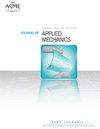Smooth Lagrangian Crack Band Model (slCBM) Based on Spress-Sprain Relation and Lagrange Multiplier Constraint of Displacement Gradient
IF 2.8
4区 工程技术
Q2 MECHANICS
引用次数: 0
Abstract
Abstract A preceding 2023 study argued that the resistance of a heterogeneous material to the displacement field curvature is the physically most realistic localization limiter for softening damage. The curvature was characterized by the second gradient of the displacement vector field, which includes the material rotation gradient, and was named the ‘sprain’ tensor, while the term ‘spress’ is here proposed as the force variable work-conjugate to ‘sprain’. In this study, the computational obstacles using nodal sprain forces in the previous study are overcome by using finite elements with linear shape functions for both the displacement vector and for an approximate displacement gradient tensor. The actual gradient calculated from the nodal displacement vectors is constrained to the approximate gradient by means of a Lagrange multiplier tensor. The gradient tensor of the approximate gradient tensor then represents the third-order approximate displacement curvature tensor (or Hessian) of the displacement field. Importantly, the Lagrange multiplier behaves as an externally applied generalized moment density that, similar to gravity, does not affect the total strain-plus-sprain energy density of material. The conditions of stationary values of the total free energy of the structure with respect all these unknowns yields the set of equilibrium equations of the structure for each loading step. Examples of crack growth in fracture specimens are given. It is demonstrated that the simulation results are independent of the orientation of a regular square mesh, and capture the width variation of the crack band, and converge as the finite elements are refined.基于应力-扭伤关系和位移梯度拉格朗日乘子约束的光滑拉格朗日裂纹带模型(slCBM
2023年之前的一项研究认为,非均质材料对位移场曲率的阻力是物理上最现实的软化损伤局部化限制因素。曲率由位移矢量场的第二次梯度表征,其中包括材料的旋转梯度,并被命名为“扭伤”张量,而“压力”一词在这里被提出为与“扭伤”共轭的力变量work。在本研究中,通过对位移矢量和近似位移梯度张量使用具有线性形状函数的有限元来克服先前研究中使用节点扭伤力的计算障碍。通过拉格朗日乘子张量将节点位移矢量计算的实际梯度约束为近似梯度。近似梯度张量的梯度张量表示位移场的三阶近似位移曲率张量(或Hessian)。重要的是,拉格朗日乘子表现为外部施加的广义矩密度,与重力类似,不影响材料的总应变加扭伤能量密度。结构的总自由能相对于所有这些未知量的定值条件,得到了结构在每个加载阶段的平衡方程。给出了断裂试样中裂纹扩展的实例。结果表明,模拟结果与规则方网格的方向无关,能够捕捉裂纹带宽度的变化,并随着有限元的细化而收敛。
本文章由计算机程序翻译,如有差异,请以英文原文为准。
求助全文
约1分钟内获得全文
求助全文
来源期刊
CiteScore
4.80
自引率
3.80%
发文量
95
审稿时长
5.8 months
期刊介绍:
All areas of theoretical and applied mechanics including, but not limited to: Aerodynamics; Aeroelasticity; Biomechanics; Boundary layers; Composite materials; Computational mechanics; Constitutive modeling of materials; Dynamics; Elasticity; Experimental mechanics; Flow and fracture; Heat transport in fluid flows; Hydraulics; Impact; Internal flow; Mechanical properties of materials; Mechanics of shocks; Micromechanics; Nanomechanics; Plasticity; Stress analysis; Structures; Thermodynamics of materials and in flowing fluids; Thermo-mechanics; Turbulence; Vibration; Wave propagation

 求助内容:
求助内容: 应助结果提醒方式:
应助结果提醒方式:


